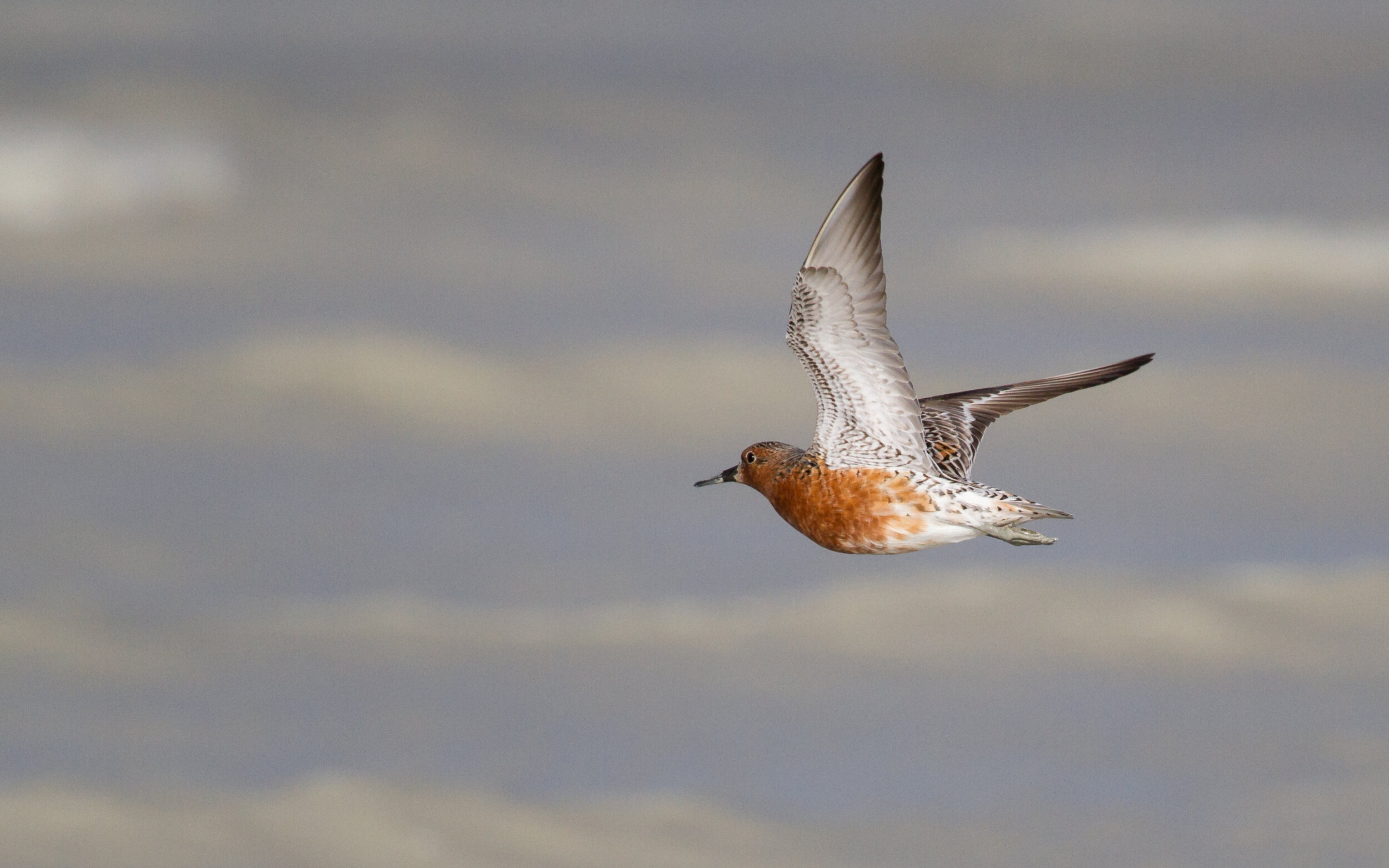from 7 March - 9 may 2022, we counted 18,057 migrants heading north over the BBO Beach:
Plus 356 Grey Plovers, 14 Asian Dowitchers, 18 Ruddy Turnstone and 1,087 not identified to species.
Photos Ric Else (2015).
Shorebird migration in Roebuck Bay - an overview
Bar-tailed Godwits lining up in Roebuck Bay, about to take off and begin their marathon flight. Photo: Ric Else 2015
Each year around 100,000 shorebirds and terns migrate from Roebuck Bay to their Northern Hemisphere breeding grounds, where they will pair up, nest and raise their chicks before returning to Broome a few months later. For many of these birds, this migration is a 20,000 km round trip, which they will undertake every year of their adult lives.
Shorebird departures from Roebuck Bay take place from early March until mid-May, peaking in the first half of April. Here at the BBO, we are in the exciting and virtually unique position of being able to watch the birds as they set off on their incredible journey. We welcome visitors to join us at this time of year to witness one of the world’s most amazing shorebird events.
Lift-off! As one, the godwits are in the air and soon begin to organise themselves in the right formation. Photo: Ric Else 2015
Most birds depart in the late afternoon, which is when BBO staff and guests gather on the beach to watch for flocks of migrating waders. Typically, we are looking out over Roebuck Bay’s magnificent mudflats, where birds of many species are busy foraging. When birds are ready to migrate, we often see them assembling out on the mud, getting ready to depart. A group of anything from 5 to 500 birds, usually all one species, gather together and arrange themselves in an east-west line. They are excited and agitated, with much chattering and wing-stretching. This is when we know they are preparing for take-off.
Suddenly, the assembled birds take to the air. Sometimes, as if doing a practice run, and they will circle and return back to their line-up on the mud. They may do several of these practice runs. Eventually though, they will take off and quickly gain height, rising high above the bay and arranging themselves in an aerodynamic v-shaped formation. Once the flock has formed the right shape and reached a suitable height, they orientate themselves to the north and begin their extraordinary journey to Asia.
Down on the beach in front of the BBO, with the warm evening light behind us, we can watch all this happening and hear the birds calling excitedly as they embark on their migration. Many of the flocks come directly over our heads as they leave the bay to the north. If conditions are favourable, we know that some of them will not land again until they arrive at their first stopover site in China, some 6,000 km away. They will fly non-stop, without eating, drinking or sleeping, for the next five days.
Soon they are in perfect shape and northward bound, twinkling in the sun as they pass right over our heads and all chattering excitedly. Photo: Ric Else 2015
On a good night, perhaps with a clear sky and a favourable wind, we can watch flock after flock assemble and make their departure from Australia. We carefully record the numbers of each species that we see leave as part of our long-term ‘migration watch’ study. We may see thousands of birds, of several species, leave during the couple of hours before nightfall.
By mid May just about all the adult shorebirds will have departed, but that doesn’t mean there is nothing left to see here. In fact about 20,000 shorebirds, mostly immatures that are not yet of breeding age, will remain here throughout the winter. By late July, some of the birds that migrated will begin arriving back again and by late September most of them will have returned. Their arrival back in Broome is not as spectacular as their departure, as the birds arrive back gradually and inconspicuously over several months. The biggest sign that they are coming home is that the shorebird flocks on the shores of Roebuck Bay increase dramatically in size.
Once back in Roebuck Bay, the birds must moult and replace their feathers, which will be heavily worn after such an arduous migration. Then they begin fattening themselves up, piling on energy-rich fat reserves in preparation for their next amazing journey to the northern Hemisphere. Once again, from mid March to mid May, the BBO staff and guests will be here in the bay, enjoying the unique opportunity to observe and record this most incredible shorebird phenomenon.
BBO staff and guests watching the action on the shore of Roebuck Bay. Photo: Ric Else 2015
When to see the migration
The very first birds to leave Roebuck Bay each year are usually Eastern Curlews, which may begin departing as early as the first week of March. Migration is in full flow from the end of the month until late April, by which time the vast majority of migrants have left Australia. The Red Knots are usually the last species to depart and plenty of fat, colourful, migration-ready birds can still be seen here into late May.
Some of the Red Knots depart very late indeed. The latest migration we’ve ever recorded was on 26th May 2014, when a couple of flocks of these knots, plus a small number of Terek Sandpipers and Grey-tailed Tattlers, caused us to rush down to the bay for an unplanned migration watch session.
Each species has its characteristic departure window, which is remarkably consistent year after year. The chart below shows the typical migration dates for selected species in Roebuck Bay (click to open larger version). For a week or so in early April, we can see almost any of these birds setting off on their journeys.
Departure windows for shorebirds in Roebuck Bay, based on the BBO’s migration watch data from 2012 to 2015.

















